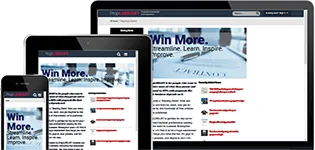When to use a question-and-answer or point-by-point proposal formats
How to pick which proposal format is best for your circumstances
Q&A or point-by-point proposal formats are so easy. You don’t have to give much thought to the outline. But that’s not the reason to choose them. Easy is not always the best.
What should drive your approach to creating the outline for your proposal is what the customer wants to see in your proposal and where they expect to find it. You do not want to lose just because the customer didn’t see things where they expected them and didn’t go looking for them. What information do they need to reach a decision? In what sequence?
Remember, proposals are not read (like a book), they are evaluated. People don't want to read every word. They only want to read the parts they need to in order to make their decision. They need to be able to find these quickly.
Don't get thrown out
The first goal for proposals is to not get thrown out. If the customer has given you instructions regarding the outline or proposal organization and you do not follow them, they may throw out your proposal without even reading it.
If there is an RFP, you should start there. Your outline should make it easy to find what they will be looking for. Usually, this is best done by putting things in the sequence and terminology used in the RFP. Within the structure mandated by the RFP, you can add more headings of your own underneath theirs if needed.
That might lead you to a Q&A or point-by-point low level outline. Or not. If the RFP itself specifies a Q&A or point-by-point response format, then you are lucky because it is clear what the customer expects and you’re not just doing it because it is easier.
Should you choose a Q&A or Point-by-Point format?
As long as they don't conflict with the RFP, there are many ways to organize the material you want to present. A Q&A format is best when the customer has given you questions to answer, or when you can anticipate the questions that the customer will have. A point-by-point response is best when that suits the nature of your offering. This can happen when there are specific locations, components, or details about your offering that fit with the customer’s needs or understanding.
What about other alternatives?
But not all offerings lend themselves to a Q&A or point-by-point response. A proposal to provide complex services or a solution might not have a finite set of objective components to structure your response around. They might be better suited to organizing based on:
- Results
- Processes
- Functions
- A work breakdown structure
- Risks
- Or something else that matters to the customer
If telling a story is part of your proposal strategy, a Q&A or point-by-point response format can also make it more difficult.
If the customer will have a formal evaluation process, like they do in government procurement, you might organize your response first around the RFP instructions, then the evaluation criteria, and then the offering in response to the requirements in the statement of work. Organizing around the way the customer makes decisions or will perform their evaluation is a powerful way to build your outline.
How do you choose the best outline format for a proposal?
The best outline format is one that the customer thinks is best, and not necessarily the one that you think makes the most sense. For the customer, proposals are a decision-making tool. Q&A outlines have the advantage of helping to make sure you answer all the questions that a customer might have. But not all subject matters are best organized around questions. You should choose the outline format that will:
- Not get you thrown out
- Meet the customer’s expectations
- Best support the customer’s evaluation or decision-making process
- Facilitate telling your story
- Help guide them to realize that your proposal is their best alternative
Consider each of these carefully before committing to a Q&A or point-by-point outline format for your proposal.
Carl Dickson
Carl is the Founder and President of CapturePlanning.com and PropLIBRARY
Carl is an expert at winning in writing, with more than 30 year's experience. He's written multiple books and published over a thousand articles that have helped millions of people develop business and write better proposals. Carl is also a frequent speaker, trainer, and consultant and can be reached at carl.dickson@captureplanning.com. To find out more about him, you can also connect with Carl on LinkedIn.


